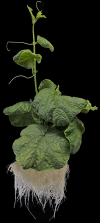An improved digestion and analysis procedure for silicon in plant tissue
- PMID: 37682894
- PMCID: PMC10490927
- DOI: 10.1371/journal.pone.0289151
An improved digestion and analysis procedure for silicon in plant tissue
Abstract
Silicon (Si) in plant tissues reduces abiotic and biotic stress, but it is incorporated as silica (SiO2), which is difficult to solubilize for analysis. We modified an oven-induced tissue-digestion and analysis method to improve Si solubilization and validated its accuracy by quantifying the mass-balance recovery of Si from the hydroponic solution and plant tissues of cucumber (Cucumis sativus). Leaf, stem, and root tissues were dried, finely-ground, and digested in 12.5 molar sodium hydroxide at 95°C for 4 hours. Solutions were then acidified with 6 molar hydrochloric acid to achieve a pH below 2 for measurement of Si using the molybdate blue colorimetric method. Interference of phosphorus in the analysis was minimized by increasing the addition of oxalic acid from 0.6 to 1.1 molar. We recovered 101% ± 13% of the expected Si, calculated using mass-balance recovery, in leaf, stem, and root tissues across 15 digestions. This Si recovery was fourteen-fold higher than the standard acid-extraction method and similar to a USDA-ARS alkaline-extraction method. Our procedure offers a low-cost, accurate method for extraction and analysis of Si in plant tissues.
Copyright: © 2023 Langenfeld, Bugbee. This is an open access article distributed under the terms of the Creative Commons Attribution License, which permits unrestricted use, distribution, and reproduction in any medium, provided the original author and source are credited.
Conflict of interest statement
The authors have declared that no competing interests exist.
Figures
References
Publication types
MeSH terms
Substances
LinkOut - more resources
Full Text Sources


